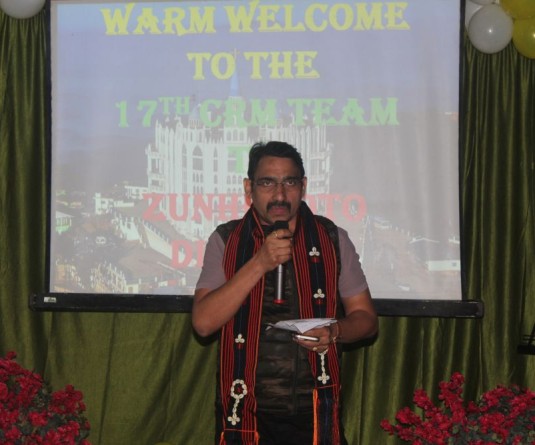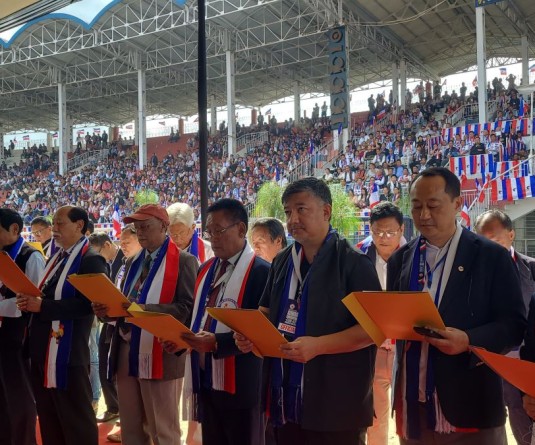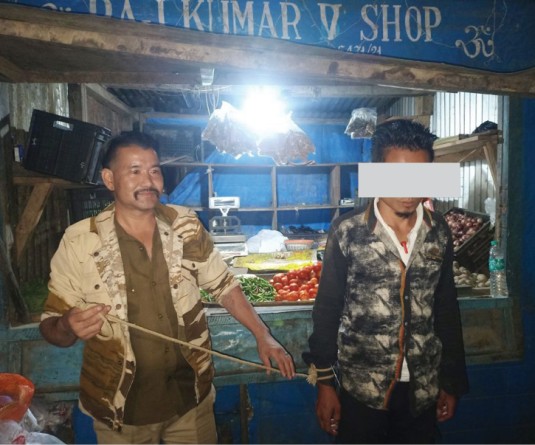
Mokokchung, February 19 (MExN): The dry days are here. With days getting longer and warmer after the cold December and January months, the air is dryer and the sky looks bluer as the first gusts of the northwesterly winds make their presence felt in the district. Although the sky is sometimes overcast with dark clouds, the people do not expect any heavy rain – “it never rains heavily this time of year” – even the cloudiest of days would be simply cleared by the winds. For the people of Mokokchung, like any other year, this is the season to brace themselves for long weeks of water scarcity as water sources dry up and the pink blossoms on the peach trees are blown off the trees by the strong winds.
The effect can already be seen in this picturesque town dominated by the Ao people. In different places of this hill town, the early morning and evening roads and footpaths can be seen dotted with children and adults carrying either a plastic container – usually an empty Britannia milk container – in baskets, or two buckets on a bamboo bar. They walk briskly, and return again and again to the well with a natural spring until they are sure they have enough water to suffice for the day’s washing, cooking and cleaning. This will be a routine affair for the next few months until the rain gods smile on the parched lands.
The scene is more or less the same everywhere; every locality or neighborhood in the town has a well with a natural spring from which the citizens fetch water. It is the community well, and it is preserved with great care – almost all localities do not allow washing of clothes or vehicles or bathing in their ‘well’. Defaulters are usually fined a sum of Rs.500. However, these community wells which are usually deserted during the wet season are now crowded with people waiting to fetch a bucket of water. In some wells, citizens have to wait for long hours because the queue is either too long or the water from the spring is so little. The cold morning and evening hours do not deter the citizens from waiting at the wells.
On the main roads can be seen the popular pickup truck – Tata 207, or a “mini Tata”, a jargon used by the common people for a medium sized truck) – carrying two to six ‘Sintex’ (another jargon meaning a huge plastic container meant for storing water), ferrying water to those who can afford it. A regular customer disclosed that he usually pays Rs.300 for one thousand litres of water. He considers it quite reasonable, since the water traders also pay a minimal amount of taxes to the landlords from where the water is fetched on the vehicle, he reasons. However, this is just the beginning; sometimes the price of the water for a thousand litres could go up to Rs.400 and more, a regular customer disclosed.
Mokokchung has had a history of water scarcity for many, many years in the past. Usually this shortage of water is most severe during the months of February, March and April until the monsoon rains arrives. The shortage of water was also felt most during a time when the PHED water supply was more or less non-existent. (People, in the past, would sarcastically comment that the PHED used to supply water only when it rained.)
However, it has been a few years since the PHE department of Mokokchung, through an agreement, is draining water from a village in Zunheboto to be supplied to the town’s populace. The department also initiated a new method of billing – meter billing – which could exactly tell how many litres of water a household had used from the department. The public was happy and many got ‘connections’ to the PHED pipelines. Others who had wells in their homes, or could not afford the PHED water supply, managed either by fetching water from the natural springs or from their own courtyard.
However, the PHED can no longer supply water twice a week as before, the simple reason, according to a PHED “water chowkidar” (in charge of opening the water pipes in a locality), being that the water in the source is also drying up. The department can supply water only once a week now, he says.
Even the private wells dug in the courtyard by various families is going dry. Interestingly, the people here fear that water shortage could be the severest this year, because of the scanty rainfall last year, and fear that water tables must have depleted due to the scanty rainfall. It will be a long two months from now, until the rains come. A year in the past, the rains did not come till the end of June, much to the misery of the people.
Call it an effect of climate change, or whatever you like, but for the people of Mokokchung this cycle of water scarcity is simply a part of nature, and the dry spell will end once the monsoon season splashes the town with its torrential rains for months. So, fortunately, no one is complaining yet, they are just waiting for the monsoon!






